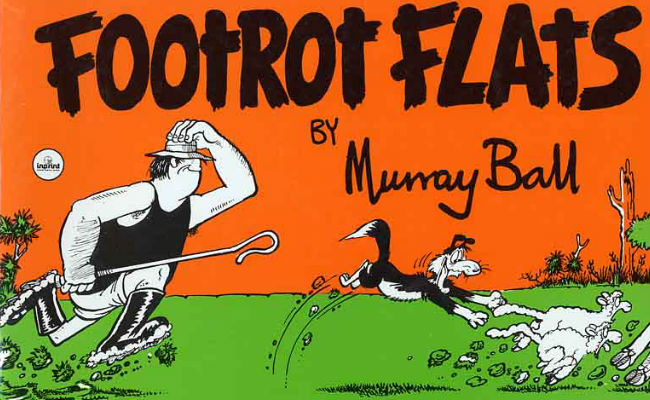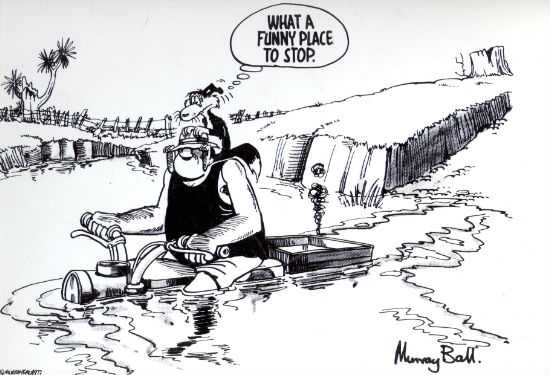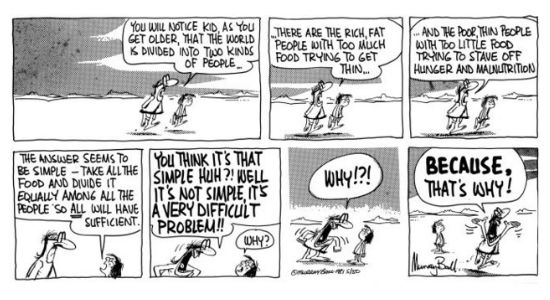
One of my fondest childhood memories is lying sprawled on the family room floor with comic books spread out before me, everything from British comics like Cheeky Weekly and Whoopee through to Peanuts, Tumbleweeds and Murray Ball’s Footrot Flats (1975-1994).
It’s that last title that has particular resonance for me at the moment as I reflect upon the much-loved New Zealand cartoonist’s passing over the weekend from Alzheimer’s Disease, a cruel way for anyone to go but especially as cleverly witty, gloriously down to earth and funny as Murray Ball.
I fell in love with Dog, the central character for all intents and purposes, in Footrot Flats, a comic strip set on a typical New Zealand farm that met more than its fair share of adversity, all of it filtered through Dog’s thought-bubble perspective and that of Wal Footrot, Dog’s laconic owner and the wrangler of a posse of gorgeously idiosyncratic friends, loved ones such as girlfriend Cheeky and niece Pongo, and the otehr animalian inhabitants of the farm such as Horse, a damnn near invincible cat and Prince Charles, the poncy Welsh Corgi who belongs to Wal’s prim and proper Aunt Dolly.

Unlike Snoopy, another comic strip canine favourite of mine, Dog was unabashedly a dog; not for him the type of sage anthropomorphic insights that we’ve come to associate with many an ink-and-pen animal.
Not that he was stupid by any stretch; Dog knew what was what and reacted accordingly; rather he reacted to things as a dog might, with wry amusement and understanding sure and even a little advice as needed – he was not adverse to some rugby tips when needed – but exactly as you might imagine a dog responding (see the panel above).
In keeping with Ball’s down to earth persona and wish to portray New Zealand farm life as realistically as possible, the scenarios that Dog and Wal found themselves were the stuff of everyday rural life – fences that needed to be replaced, flooded paddocks and rugby games that needed to be played.
You may have thought that would have rendered the strip far too niche to be widely appealing, however Footrot Flats was written with such good humour, some sweet insight for the human condition and a reverence for the bonds of family, friends and community, no matter how they might sometimes amuse you, that you couldn’t help but be drawn in.
I mean, I was most assuredly not a New Zealand farmer nor really connected intimately with farming life, despite growing up in regional far northern New South Wales, Australia, but I fell hook, line and sinker for Ball’s magnificent creation, loving Dog and the crew so much that one birthday, close friends gave me a wood-burned version of Dog in his iconic pose (see top of the post).
It was honestly one of the best presents I have ever received and even now, 40 years later, it is among my most treasured possessions.

Another comic strip of Ball’s was Stanley the Paleolithic Hero, which ran in the UK’s Punch magazine in the 1970s, along with All the King’s Comrades, was another offbeat favourite of mine.
I loved Stanley’s thoughtful approach to life so much that when I had to do a school project on the paleolithic era, back when such undertakings involve paper, glue and lots of handwritten articulation, I decorated it, probably against regulations (even if it was, my teacher happily went along with my idiosyncratic choice), with lots of Stanley comic strips.
The thing with all of Ball’s comic strips was that they both beautifully drawn and thoughtful in their narrative intent, gems of brief, pitch-perfect comedic articulation that came with richly-drawn (literally) characters and heartfelt emotional resonance.
Ball’s work was such a high quality that he gained himself some pretty impressive fans, according The Guardian‘s obituary, one in particular dovetailing pleasingly with another great comic strip obsession of mine.
“Ball and Peanuts creator Charles M. Schulz had a mutual admiration of each other’s work, with one Footrot Flats strip showed Dog laughing at a Snoopy cartoon. Schulz wrote the introduction to the only Footrot Flats volume ever to be published in the United States.
“‘The dog is definitely one of my favorite cartoon characters of all time,’ wrote Schulz of Ball’s ‘wonderful strip’. ‘Being a fanatic about comic strips, I am always either very impressed by good drawing, or saddened by poor drawing. I love the way Murray draws these animals. I love the relationship among all of the characters, and am especially fond of the absolutely original approach to the humor.'”
But Ball didn’t just enrich Schulz’s life; he made the lives of anyone who read his elegantly pithy, funny, clever work better, gracing us with characters that meant something to each other and to us, whose lives were real, vibrant and funny and who came to be a part of our lives.
That is the ultimate accolade for any creative person and as Murray Ball joins Dog in heaven – the character was based on Ball’s own dog who died in the early ’90s, partly precipitating the end of the comic strip – we can only hope he knew how much he was loved and admired and how very deeply he will be missed.